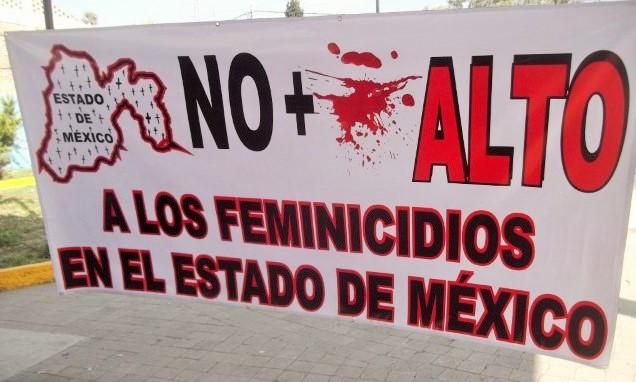Amid a rising tide of widespread violence in the country[1] the State of Mexico issued its first-ever Gender Alert. AWID spoke to Maria Luz Estrada and Patricia Bedolla of the National Citizen’s Feminicide Observatory to discuss what this means for women human rights defenders in Mexico State.
On July 28, 2015 the - National System to Prevent, Treat, Punish and Eradicate Violence against Women (SNPASEVM) declared, for the first time ever, a Gender Alert in 11 municipalities of the State of Mexico - Ecatepec, Nezahualcoyotl, Chalco Valley, Toluca, Tlalnepantla, Naucalpan, Chimalhuacán, Tultitlan, Ixtapaluca, Cuautitlan Izcalli and Chalco.

Thanks to the pressure and work of women's rights organizations and mainstream civil society organizations, authorities in the State of Mexico were made to acknowledge the seriousness of the systemic violence against women. A multidisciplinary and inter-institutional group[2] conducted an investigation and issued a report, based partially on information offered by the Observatory and Mexican Commission for the Defense and Promotion of Human Rights (CMDPDH), and the government of the State of Mexico. The Observatory notes "said research was completed via analysis of official statistics, interviews with authorities and with relatives of victims of femicide".
Maria Luz Estrada points out that "recognition is a breakthrough. The State acknowledges that there is a serious problem of feminicide impunity, given that about 70% of women's murders are not investigated; and recognizes that there are 1500 missing young women, most of them from seven of the eleven municipalities under this Gender Alert."
Gender Alert
The Declaration of a Gender Alert is a collective action mechanism established by the “Law on Women's Access to a Life Free of Violence” of 2007. Article 22 proposes a set of emergency governmental measures to confront and eradicate feminicidal violence in a given region, and can be exercised by individuals or by the community itself. According to Estrada the assumption is that "these measures are temporary, but given the situation in Mexico we believe they won't be, as we've witnessed serious decomposition of our justice system, along with public policies that are totally inefficient in eliminating inequalities, let alone violence against women, which has been a major challenge for governments."
Since 2008 the Observatory has submitted numerous Gender Alert requests that have been repeatedly denied. The first request related to the murders of women journalists in Oaxaca, and as Estrada points out "because there were high levels of community violence, a situation where they were disappearing and assassinating women in that area. They did not accept our request and asked us to submit evidence, meaning we had to prove what was happening, whereas that is the specific investigation the authorities are required to carry out." Alert requests were also made for Guanajuato, and starting in 2010 for the State of Mexico.
According to information gathered by the Observatory, 54% of the murders and incidents of feminicidal violence have taken place in ten of the State of Mexico municipalities under the alert. Estrada points out that "between 2005 and 2010 the Observatory recorded 522 cases of women whose murderers remained unknown. We had 100 unidentified female victims, and documented four thousand reports of rapes that weren't being investigated or tried, all under the administration of current President Enrique Peña Nieto."
The Observatory informed and drew the government's attention to how brutal the murders were, and how victims were then dumped in vacant lots or by the roadside. Obviously these crimes were not common crimes but clear cases of feminicide. Patricia Bedolla states that, "rejecting the request for issuing the Gender Alerts has caused this problem to intensify, and today the issue has expanded from women being murdered, to include women disappearing. The issue of disappearance is a new topic which is incorporated in this struggle, we at first spoke of feminicide and now speak of missing young women in the State of Mexico."
Protocols and the backdrop of violence
A variety of issues could point to the causes of violence against women in the State of Mexico. One factor, Estrada explains, is that "Mexico State serves as a crossroads for internal and external migrants, crossing the border via the train known as "The Beast". There is the also the different networks of organized crime, some of them involved in human trafficking, and also organized crime within the State of Mexico regarding drug trafficking, contraband, where the issue of women becomes cross-cutting, depending on how these criminal networks exploit women."
Since the 2009 ruling by the Inter-American Court of Human Rights (IACHR) in the case known as Cotton Field[3], the State of Mexico has had to institute a criminal Investigation Protocol for murders, disappearances and sexual violence. The Observatory contributed to its creation, especially guiding the development of the Penal Protocol to help justice officials in identifying a crime as feminnicide. Estrada explains " if the authorities do not have a criminal code to assist them, the Protocol becomes a manual that they do not use, the only constraint was to establish an understanding whereby they became able to distinguish homicide from feminicide,"
Bedolla notes that a problem with these protocols lies in the interpretation of feminicide. For a good while it has been interpreted by the authorities “just from the domestic violence perspective; and resulted in the creation of the violent partner profile and the use of techniques such as psychological autopsy, the Observatory says it is a misused tool, and should not be used within these investigations."[4]
Bedolla stresses the need to discuss "what we mean by feminicide". For instance in cases of sexual violence[5] the burden of proof operates differently. Ciudad Juarez gave us insights into how women could be sexually abused without the need of having being raped. The degrading injuries, the ways in which to inscribe anger onto a woman's body. Something new is women being held incommunicado. Women are trafficked, deprived of their liberty and are subsequently killed. Bedolla and Estrada agree that are review of interview methods is required to highlight how gender dynamics manifest in "the subjugation, domination, and discrimination in the ways women are killed.
Both interviewees point out that there are numerous Protocols but there is no political will. Estrada explains, “The problem with the State of Mexico is that the perpetrators involved are the very same police officers who rape women, who are involved in trafficking networks and are embedded within the very fabric of these networks. This is why this was the first Gender Alert decreed of the thirteen applications sought since 2008."
Involvement of women's organizations and civil society in the next steps
To track and monitor proper compliance with the Alert, an interdisciplinary and inter-organizational group is being established, which will involve civil society for the first time. Estrada confirms that "The Observatory will be part of this task force, and we are already working on establishing follow up agreements with the Ministry of the Interior.
The Observatory has 12 cases under the Alert Declaration, which will be used as indicators to show progress being made in investigations, especially in cases of murders of women that aren't investigated as feminicide, and in cases of missing young women. They also hope that organizations specialized in security and such investigations will be involved in the process.
Estrada and Bedolla insist that other laws and protocols are not needed, as Estrada explains, "now what we have to do is implement the Alert and the safety, security and justice measures within it and start working with authorities. We're facing a very big challenge."
* The author is grateful to Veronica Vidal Degiorgis and Marusia López.
